PRINCETON, NJ -- By tapping Alaska Gov. Sarah Palin to be his running mate, John McCain is in part gambling that putting a female reform-minded governor (who happens to be staunchly pro-life) on the Republican ticket will help to cut into Obama's substantial lead among female voters. Obama is now countering that strategy by running ads in swing states highlighting McCain's and Palin's opposition to abortion.
Who stands to gain? To start with, female voters as a whole tilt pro-choice over pro-life in how they describe their abortion stances, 50% to 43%. Among the independent and Democratic women who are the primary focus of this battle, the balance of opinion is a bit more strongly pro-choice.
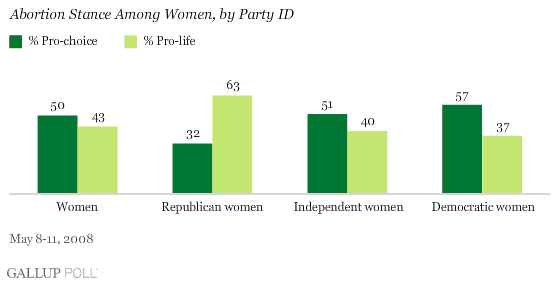
However, as Ā鶹“«Ć½AV polling in 2008 and all recent past elections shows, only a small fraction of Americans are highly activated on the abortion issue. Most Americans downgrade the importance of abortion to their vote, saying either that it's not a major issue for them (37%), or that it's just one of many important issues they consider (49%). Only 13% of Americans told Ā鶹“«Ć½AV in May 2008 that they vote only for candidates for major offices who share their views on abortion.
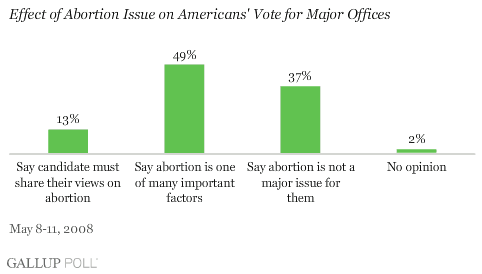
That may largely explain why 32% of Republican women call themselves pro-choice, yet only 7% of Republican women are voting for Obama. Similarly, in contrast to the 37% of Democratic women who say they are pro-life, only 9% are voting for McCain. Abortion is simply not a pivotal issue for these voters.
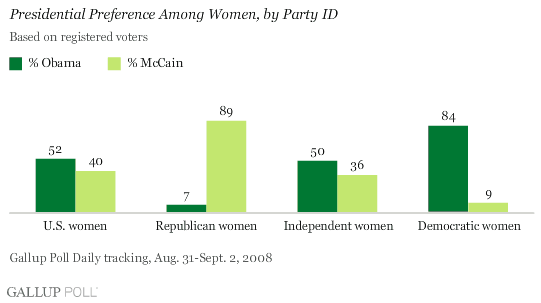
Although a third of Republican women are pro-choice, McCain's selection of Palin last Friday already appears to have helped him with his female Republican base. , not less likely, in polling from Saturday to Monday.
There is something closer to a 1-to-1 correspondence between abortion views and presidential preferences among independent women, at least numerically. Independent women split 51% vs. 40% pro-choice over pro-life in May. Today they are voting for Obama over McCain by 50% to 36%.
But the abortion issue appears to be even less of a factor for independent women than it is for their partisan counterparts. According to Ā鶹“«Ć½AV's May 2008 Values and Beliefs survey, 20% of Republican women said they vote only for candidates who share their views on abortion, as did 14% of Democratic women but only 8% of independent women.
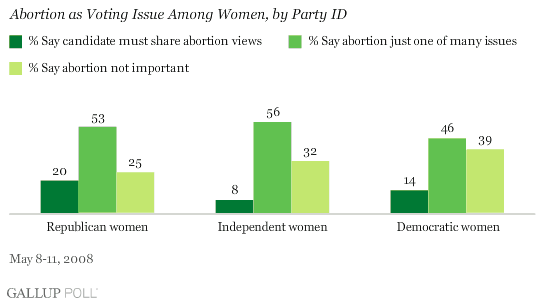
Roe v. Wade Versus Partial-Birth Abortion
To the extent that abortion politics makes a difference in the 2008 election, it could come down to how the candidates exploit the public's strong feelings on two specific issues -- overturning the landmark Supreme Court Roe v. Wade decision legalizing abortion on the one hand, and the legality of late-term abortions, including the so-called partial-birth abortion procedure, on the other.
Americans (men and women alike) , at least in the first trimester, and the majority oppose overturning Roe v. Wade. Thus, highlighting the risk that McCain would appoint judges who seek to overturn Roe v. Wade could be a potent pro-choice selling point for Obama.

From McCain's perspective, the strongest potential pro-life message he can use could be Obama's positions against a ban on partial-birth abortion and against a law that would give a child who survives an abortion the full rights of a human being. Ā鶹“«Ć½AV polling has consistently shown a high percentage of Americans in favor of making partial-birth abortion illegal, and, in general, widely opposed to late-term abortions.
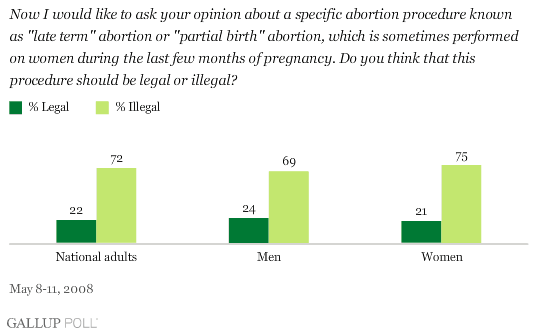
Bottom Line
The 2008 Republican and Democratic presidential candidates present a sharp contrast on abortion policy, and that contrast is now bursting into the open with the emerging battle for female voters.
Whether the selection of Palin as his running mate helps or hurts McCain with independent and Democratic women going forward will only partially depend on how Obama and McCain play the abortion issue. Relatively few Democratic women and even fewer independent women say abortion is the most important issue they consider. Palin's story as a working mother may prove more compelling to women attracted to the idea of breaking the presidential glass ceiling.
If, however, Obama and McCain both take the gloves off and seek to paint each other, respectively, as a dangerous opponent of a woman's choice versus a radical proponent of late-term abortions, the issue could resonate with more than the few female voters who typically care. Many women are cross-pressured in their political views (pro-choice Republicans and pro-life Democrats) so there is significant room for changing voter preferences on the issue on both sides. And if the arguments cut deeply enough, they could also be influential with independents.
Survey Methods
The latest abortion public opinion results are based on telephone interviews with 1,017 national adults, aged 18 and older, conducted May 8-11, 2008. For results based on the total sample of national adults, one can say with 95% confidence that the maximum margin of sampling error is Ā±3 percentage points.
Interviews are conducted with respondents on land-line telephones (for respondents with a land-line telephone) and cellular phones (for respondents who are cell-phone only).
In addition to sampling error, question wording and practical difficulties in conducting surveys can introduce error or bias into the findings of public opinion polls.
To provide feedback or suggestions about how to improve Ā鶹“«Ć½AV.com, please e-mail feedback@gallup.com.
